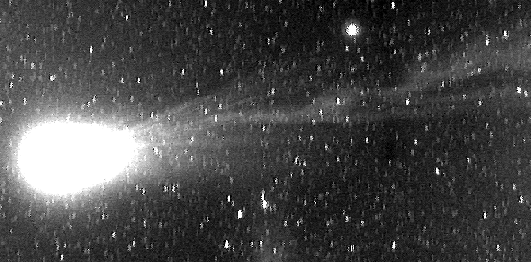Credit & Copyright: Oscar Pizarro, 1-meter Schmidt Telescope, La Silla, Chile,
European Southern Observatory
Explanation:
This picture of
Comet Hyakutake was taken on March 14, 1996. Structure in
the ion tale of
Comet
Hyakutake is now clearly visible. An ion tale forms
as a comet nears the Sun.
Sunlight causes gas and dust to boil off the
comet's solid nucleus. Charged gas - called ions - are then accelerated
away from the
Sun by the
solar
wind - fast moving particles streaming out
from the Sun's corona.
The ion tale will appear blue and glows by
fluorescence.
As Comet
Hyakutake gets closer to the Sun during the next month, a
dust tail is expected to be visible as well.
Dust tails shine by light
reflected from the Sun.
Comet tails point away from the Sun, even as a
comet moves away from the Sun. For observers in the Northern Hemisphere,
Comet
Hyakutake should appear tonight in the eastern part of the constellation of
Virgo and should be about magnitude 2.5. The comet will look the most
impressive in the darkest skies - in a city you are likely to see only a
fuzzy blob!
Information:
The
Scale of the Universe Debate in April 1996
1999 2000 2001 2002 2003 2004 2005 2006 2007 2008 2009 2010 2011 2012 2013 2014 2015 2016 2017 2018 2019 2020 2021 2022 2023 2024 2025 |
Январь Февраль Март Апрель Май Июнь Июль Август Сентябрь Октябрь Ноябрь Декабрь |
NASA Web Site Statements, Warnings, and Disclaimers
NASA Official: Jay Norris. Specific rights apply.
A service of: LHEA at NASA / GSFC
& Michigan Tech. U.
|
Публикации с ключевыми словами:
comet Hyakutake - tail - комета Хиякутаке - кометные хвосты - кома
Публикации со словами: comet Hyakutake - tail - комета Хиякутаке - кометные хвосты - кома | |
См. также:
Все публикации на ту же тему >> | |
